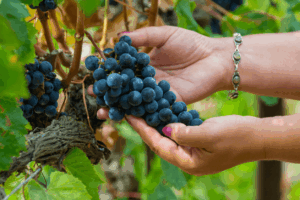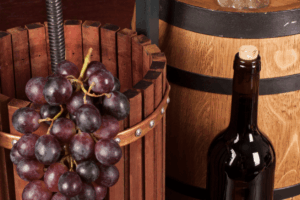Wine can feel intimidating when you’re just starting out. If you’re thinking of sourcing grapes for winemaking or learning more about varietals, explore how we support first-time and experienced producers alike through our main services. If you’ve ever scanned a wine label and wondered what “Shiraz” really means, and where to find an excellent Italian example, this guide is for you. It introduces the basics of wine varietals, explores why shiraz grapes continue to gain global popularity, and provides a grounded look into styles, regions, and tasting characteristics based on firsthand experience in the field.
What does ‘varietal’ mean in wine?
In the trade, we call a wine a “varietal” when it consists primarily of one grape type. New World regions like Australia and California label bottles as Shiraz, Cabernet Sauvignon, or Malbec. In contrast, Old World regions like France, Italy, or Spain typically name wines by region, such as Châteauneuf-du-Pape or Rioja, with the grape type implied. Understanding how to decode these labels makes choosing the right bottle far less of a gamble.
What are shiraz grapes and why are they popular?
For a deeper dive into the characteristics of this varietal, you can also explore our dedicated shiraz grape profile.
Shiraz grapes also known as Syrah in France thrive in warm, dry climates. They develop thick skins and firm tannins and yield bold, structured wines. Growers in southern Italy, especially Sicily, Puglia, and Abruzzo, value Shiraz for its reliability in challenging growing seasons. When those deep-purple grapes come in heavy and fragrant, you know you’re in for a strong fermentation run. This kind of consistency keeps Shiraz in steady demand. Whether you’re making wine at home or at scale, shiraz grapes are one of the most forgiving red varieties to work with.
How is shiraz different from other red grapes?
Shiraz gives winemakers more leeway than most red varietals I’ve worked with. Merlot can lose structure if it overripens. Cabernet often needs a blend to round it out. Shiraz, though, stands on its own. I’ve crushed fruit from cooler inland plots and warmer coastlines, and Shiraz always gave us something expressive. In warmer zones, expect alcohol and richness. In cooler ones, spice and freshness take the lead. The adaptability of shiraz grapes across these climates makes them a preferred option for producers seeking reliable yield and flavour.
Where are shiraz grapes grown?
1. Italy (Sicily, Puglia, Abruzzo)
- Italian Shiraz, grown under Mediterranean conditions, delivers powerful, fruity red wines with notes of blackcurrant and blackberry. In cooler sites, expect earthier textures and more pronounced tannins. It blends especially well with Nero d’Avola, Merlot, or Cabernet Sauvignon.
2. Rhône Valley, France (Old World Syrah)
- Rhône growers produce structured, cellar-worthy wines with spice, dark berries, and herbal notes.
3. Australia (New World Shiraz)
- Barossa Valley, McLaren Vale, Grampians, and Hunter Valley consistently yield ripe, fruit-driven wines.
- McLaren Vale Shiraz shows generous fruit and integrated oak, while Grampians versions lean toward spice and structure.
4. Other Regions
- Stellenbosch and Paarl in South Africa produce robust, ripe styles.
- Hawke’s Bay in New Zealand focuses on balance, finesse, and cooler-climate spice.
- California and Washington offer a range from savoury and smoky to jammy and rich.
In each of these regions, shiraz grapes respond differently to soil, sunlight, and vineyard management, giving winemakers a broad stylistic palette to work with.
How are shiraz grapes used in winemaking?
If you’re interested in using shiraz grapes in your own production whether as a home winemaker or part of a larger team CM Watermelons can help. Our grape transport and delivery service ensures that fruit arrives in peak condition, ready for pressing or fermentation.
At harvest, I check more than sugar levels. You want pliable skins, mature seeds, and that telltale aroma that says, “This is ready.” After destemming and crushing, I prefer fermenting in open-top vats especially for small-lot Shiraz so I can manage cap development closely. Extended maceration draws out colour and tannin. And whether you’re aging in American or French oak, Shiraz handles the wood beautifully, gaining texture without losing its fruit.
In our winery, we’ve always valued shiraz grapes for their colour density and natural extraction, which make them perfect for both short-term drinking and long-term aging styles. You’ll find a more technical breakdown of their structure and ripening behaviour on our shiraz grape page.
What does shiraz wine taste like?
Young Shiraz delivers dense fruit such as blackberry, plum, sometimes black cherry underpinned by pepper and warm spice. Add time in oak, and you might pick up mocha, leather, or sweet tobacco. The best bottles from cooler zones show restraint and elegance, while warm-region Shiraz brings immediate power.
Which shiraz wines should beginners try first?
Start with an Italian Shiraz so you can appreciate the bold, fruit-driven expression. McLaren Vale remains a great choice for its generous but never clumsy quality. A bottle with 14.5% ABV, matured in second-fill American oak, will show you exactly what modern Shiraz does best. For more structure, look to Crozes-Hermitage. And if you’re making your own, pick grapes with concentrated colour, firm skins, and tight clusters those cues suggest depth in the final wine.
Even a 30-minute decant makes a difference. I’ve poured young Shiraz straight from bottle and again after decanting every time, the second glass wins.
What food pairs well with shiraz?
Shiraz rewards bold pairings:
- Italian Shiraz: Rich and fruit-forward, it matches beautifully with pasta in hearty meat sauces and roasted lamb.
- Australian Shiraz: Excellent with grilled lamb, beef ribs, or aged cheddar.
- French Syrah: Ideal for duck, mushroom ragout, or root vegetable stews.
- South African Shiraz: Matches bold flavours like peri-peri chicken or spice-rubbed steak.
If your dish is big on flavour, make sure the wine can hold its ground.
How do you choose a good shiraz wine?
Origin comes first. If you’re after powerful fruit and early ripeness, look for an Italian Shiraz from Puglia. Want plush and ripe? Go Australian or Californian. Prefer savoury tension? Rhône or New Zealand. Words like “barrel-aged” or “peppery” often hint at a bolder style that’s where Shiraz shines. In my experience, wines from respected co-ops or family-run vineyards even under £15 often outperform bigger-name brands.
If you’re sourcing grapes, ask when they picked and how the fruit looked. Ask if they irrigated. Those details tell you more than any sales pitch.
How should shiraz be served?
Serve Shiraz slightly cool about 16–18°C. Use a large glass with a broad bowl so the aromatics can rise. With food, I’ve had great results pairing Shiraz with braised meats, venison, or lentils cooked down with smoked paprika. The wine’s structure supports depth and fat.
Why is shiraz a good wine to start with?
Shiraz teaches you a lot in one bottle. You learn how tannins grip, how oak softens, how climate shifts flavour. It’s a winemaker’s grape, but also a drinker’s grape—easy to enjoy young, rewarding with age. I’ve seen new producers fall in love with it after a single vintage.
What should beginners know about shiraz wine?
If you’re starting out, try Shiraz from three distinct regions. Get one from Italy, one from the Northern Rhône, and one wild card such as Sicily (if not already chosen) or the Central Coast of California. Taste them side by side. Note how the spice, weight, and finish evolve. Return to them later. Your taste will shift as you go. Let the wines teach you along the way.
If you’re serious about learning wine, start with a grape that teaches you something every time you taste it. For me, that’s Shiraz.
Interested in sourcing shiraz grapes directly? CM Watermelons supplies fresh wine grapes from Italy every autumn ideal for home or commercial winemakers. Register your interest here



